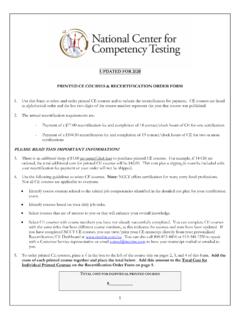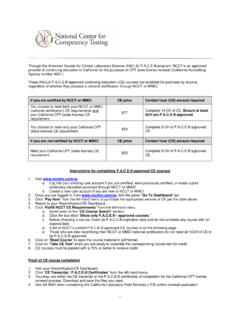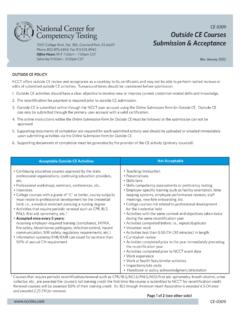Transcription of NCMA National Certified Medical Assistant Detailed Test Plan
1 7007 College Blvd., Ste. 385, Overland Park, KS 66211 Phone ; Fax Hours: M-F 7:30am - 7:00pm CSTS aturday 9:00am - 3:00pm CSTNCMA Detailed Test PlanThis Detailed test plan reflects the results of a National job analysis study that determined the critical job competencies to be tested by NCCT in this certification examination. It contains 150 scored items, 15 unscored pretest items, and candidates are allowed three (3) hours to complete the examination. This certification examination is comprised of 90-95% standard, 4-option multiple-choice items and 5-10% alternative items ( , Drag and Drop, Multi-Select, Hotspot).Number of Scored ItemsContent Categories1 1 Rev: 2020 NCMA National CertifiedMedical AssistantDetailed Test PlanEX-0508A1 Consult pharmaceutical desk references to check medications ( , drug classification, contraindications, side effects, action, routes of administration, and adverse reactions).A2 Perform basic medication related Comply with DEA and other regulatory agency guidelines for ordering, dispensing, documenting, and storing Document medication administration Comply with legal requirements for completion of prescriptions and authorization of Identify commonly used medications by generic and brand Recognize general indications for common therapeutic medications used ( , insulin for diabetics, etc.)
2 A8 Demonstrate safe medication preparation, administration, and documentation ( , dosage calculation, route, types of injections, and injection sites).A9 Administer medication Administer medication subcutaneously (SQ).A11 Administer medication intramuscularly (IM).A12 Administer medication intradermally (ID).A13 Respond to adverse Administer medication Administer medication Adhere to e-prescribing Translate prescription Administer medication sublingually (SL) or Administer medication by Instill ophthalmic medication ( , eye drops).A21 Instill medication aurally ( , ear drops).A22 Document medication administration and Document prescriptions and refills. B Patient 2A Infection, Exposure Control, and Safety2 Clinical Medical ProceduresA1 Follow CDC Standard Precautions and transmission precautions ( ,airborne, contact, droplet, hand hygiene).A2 Comply with OSHA standards for Health Care Workers ( , blood borne pathogens, SDS, needlesticks, bodily fluids).
3 A3 Perform general Medical Perform surgical Implement cleansing, disinfection, and sterilization as Handle and dispose of biohazardous Handle and dispose of Use personal protective equipment ( , gloves, gown, mask).A9 Follow patient isolation procedures ( , radiation, reverse, TB).A10 Respond to emergency situations ( , fire, biological hazard).A11 Prevent the spread of healthcare acquired (nosocomial) Practice safety procedures when using Medical equipment and supplies ( , lock wheels, gait/transfer belts).A13 Transfer patients using correct body Activate safety mechanisms for Perform adult and pediatric height, weight, and BMI measurements ( , standing, wheelchair).B2 Obtain patient vital Take a patient Use a pain scale to report patient pain Position a patient for an exam or procedure ( , Fowler s, lithotomy).B6 Perform a pulse oximetry Perform vision screening tests ( , Snellen, Ishihara, Pelli-Robson).
4 B8 Perform allergy Perform suture and staple Perform auditory acuity Perform ear Perform eye Assist the provider with patient examinations ( , physical, gynecological).B14 Recognize and appropriately report abnormal measure/screening results ( , pain assessment and monitoring).B15 Prepare and manage patient exam/treatment Adapt care to patients with special needs ( , physically, mentally impaired).B17 Perform wound care and/or dressing Assist with immobility support/splint applications ( , elastic bandage, wrist splint).B19 Assist with minor surgical procedures ( , skin prep).B20 Perform therapeutic modalities as instructed ( , crutch training, hot/cold compress, ROM exercises).B21 Provide basic patient instruction/education (hemoccult, breast/testicular self-exams, nutrition).B22 Assist with oxygen therapy ( , nasal cannula). 33 Phlebotomy21A Other Diagnostic Tests4 ECG and Other Diagnostic Tests18B23 Assist patients with spirometry ( , peak flow, PFT).
5 B24 Assist with patient-administered nebulizer Assist patients with orthotic or prosthetic Perform first aid, BLS, and rapid response Adhere to standards for patient introduction, identification, and order Evaluate pre-test conditions for patient prior to collection ( , fasting, medications).A3 Adhere to patient safety, infection control, and aseptic technique Select appropriate venipuncture equipment for the test ordered and type/age of Prepare the patient and the selected site for blood collection ( , micro-sampling, venipuncture, bacterial culture).A6 Select appropriate capillary puncture equipment for the test ordered and type/age of Take appropriate action when blood return is not established ( , collapsed vein, missed vein).A8 Follow the correct order of draw for blood samples ( , capillary, venous).A9 Identify additives in evacuated blood collection Follow the manufacturer recommendations for fill level/ratio and tube Implement precautions for patients with special needs ( , mastectomy, IV, burns, dementia, bleeding disorders , other).
6 A12 Perform venipuncture on patients of all Perform capillary punctures by Perform capillary punctures by Select appropriate bandaging supplies ( , age, allergy, skin type).A16 Perform phlebotomy Recognize and respond to complications ( , hematoma, excessive bleeding, other).A18 Anticipate pre-analytical errors and complications ( , inadequate collection amount, wrong order of draw).A19 Take corrective actions for problems with test requests, specimen transport, or specimen Perform blood culture Handle laboratory specimens per protocol ( , preservatives, light sensitivity, temperature).A22 Label specimens Take appropriate actions for misidentified patients or Process specimens for the laboratory appropriately ( , centrifuge, aliquot, storage).A25 Perform special collections ( , trace elements, newborn screen, chain of custody). A1 Perform CLIA waived point of care testing (POCT) ( , urinalysis dip stick, hemoglobin and hematocrit, coagulation, glucose, pregnancy test, fecal occult blood).
7 A2 Perform chain of custody collections ( , urine drug screening, paternity testing).A3 Perform lab instrument maintenance and Collect specimen cultures ( , wound, sputum, viral, stool, throat).A5 Instruct patients in specimen collection ( , 24-hour urine, clean catch, stool, sputum).A6 Process specimen collections Perform and record quality control, procedures for CLIA waived point of care 4B ECG Placement TechniquesC ECG RecordingA Communication5 General Office Procedures21B1 Prepare and position the patient for ECG testing ( , gowning, skin preparation).B2 Place electrodes on the patient appropriately for the test ( , stress, Holter, telemetry).B3 Use additional resources as needed for specific diagnostic tests ( , blood pressure cuff, treadmill, Holter monitor).B4 Adapt technique to patients with special considerations ( , amputee, right sided heart, pacemaker).B5 Adapt technique for special populations ( , age appropriate, isolation, special needs).
8 B6 Explain the ECG procedure to the patient ( , movement, talking, electronics).B7 Provide patient instruction regarding the Holter Provide ongoing monitoring of the patient during stress Capture and record ECG tracings on a Distinguish between regular and irregular Initiate response to life threatening arrhythmias per Monitor patient vital signs and tolerance during Prepare the report for the Transmit the report to the patient s EMR/EHR or chart. D ECG Troubleshooting and MaintenanceD1 Identify recording errors ( , improper tracing, standardization mark out of range, improper lead placement).D2 Identify causes of artifact ( , somatic tremor, patient movement, wandering baseline, AC interference, seizures).D3 Account for patients with special considerations ( , shunts, piercings, scars, pacemaker/AICD-failure to pace).D4 Correct artifacts and recording errors ( , paper placement, lead reversal, power loss, remove electronic devices, calm the patient).
9 D5 Ensure proper grounding of the ECG Check battery charge and paper Clean and store the ECG machine after Communicate effectively verbally and in Direct patients and visitors to the appropriate team member or location ( , greet, screen, prioritize).A3 Answer, evaluate, and direct incoming calls to team members using effective telephone Describe the policies and procedures of the practice to Address possible telephone emergencies Initiate the emergency response system ( , violent person in the office, fire).A7 Route or transmit Medical office correspondence to the appropriate team member via mail, fax or Proofread and/or edit office Process Medical office mail and correspondence via the appropriate shipper and postage classification ( , incoming, outgoing).A10 Ensure the availability of patient informational materials ( , pamphlets, patient education brochures). 5B Medical Office Computer ApplicationsC SchedulingD Medical RecordsB1 Maintain the integrity and confidentiality of computer-stored Maintain electronic Medical office data ( , data entry, retrieval, backup).
10 B3 Use standard office software ( , word processing, spreadsheet, database, email, internet browsers, presentation graphics applications).B4 Use Medical office software applications ( , billing, scheduling, electronic Medical records, electronic health records, financial).B5 Perform basic operator level troubleshooting on Medical office computer equipment and Manage Medical office electronic data using devices other than computers ( , tablets, mobile phones, bar code scanners, card readers/scanners, kiosks).B7 Use peripheral devices ( , printers, copiers, scanners, fax, digital cameras).C1 Matrix healthcare schedules ( , facility, resources, providers).C2 Set up patient and visitor appointments using standard scheduling techniques ( , modified wave, double booking).C3 Set up patient appointments using telemedicine and/or home Manage appointment dates and times with scheduled patients ( , confirm, cancel, reschedule, missed appointments).





